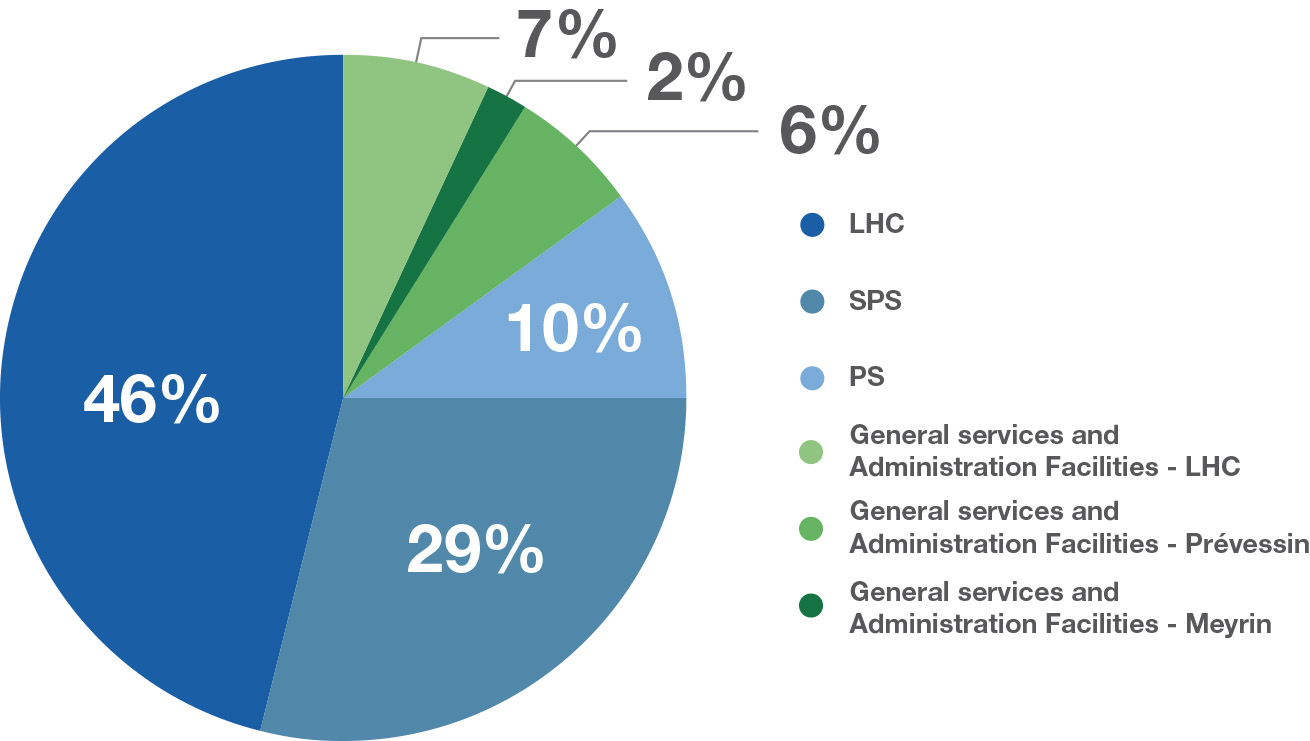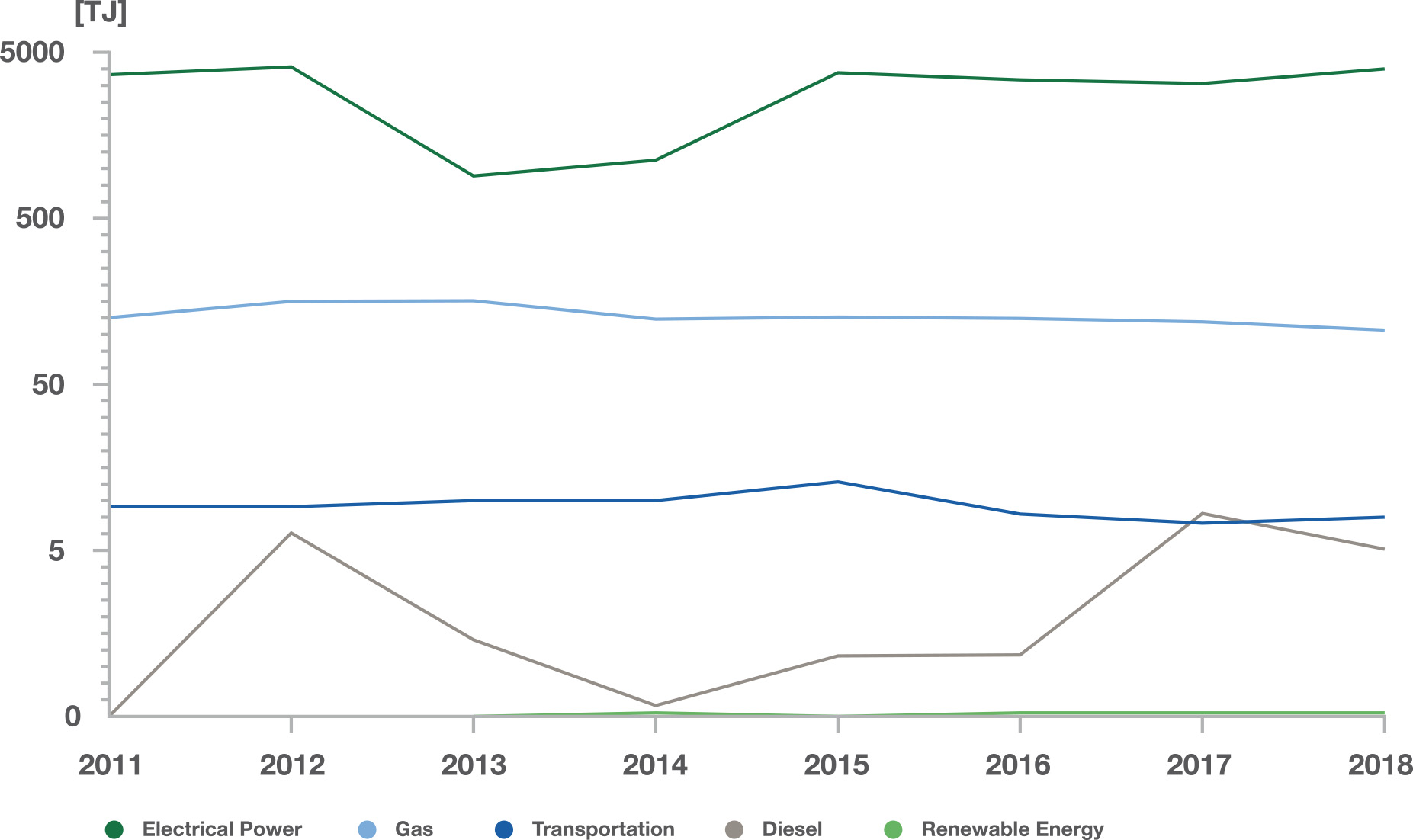
|
|
|
ELECTRICAL POWER DISTRIBUTION 2018. Distribution of the electrical consumption at CERN highlighting the large part used by the accelerator complex; PS, SPS and LHC. In 2018, the total electrical consumption was 4504 TJ (1251 GWh).
|
CERN’s unique complex of particle accelerators is responsible for most of CERN’s energy consumption. As powerful research instruments, these machines support a global community of scientists, and CERN takes every effort to run them in the most energy-efficient way possible. CERN’s peak power demand, with the full accelerator chain running, is around 180 megawatts, which is about half the capacity of the nearby Génissiat hydroelectric power plant in France.
CERN procures its electricity mainly from France, whose production capacity is 87.9% carbon-free (2017 figures). CERN uses about 4300 TJ (1.2 TWh) of electricity in years when the accelerators are running. This corresponds to about 2% of the electricity consumed by Switzerland, where CERN is headquartered, or 0.03% of consumption in Europe. Energy procurement represents around 5% of CERN’s budget. In years when the accelerators are not running, consumption is between 30% and 50% lower. Electricity is the major source of energy used at CERN, constituting around 95% of CERN’s energy in a typical year. The Organization also consumes natural gas for heating, petrol for its fleet of vehicles and diesel for emergency generators. Non-accelerator consumption accounts for 15% of the total. Fossil fuel consumption was 232 TJ (64.4 GWh) in 2018.
CERN’s main product is data produced in particle collisions and recorded by experiments. The Organization constantly strives to make its accelerators more efficient at delivering data. The LHC, for example, delivered twice as much data per unit energy in its second run compared to its first. A metric to formally quantify and illustrate this is under development and will appear in CERN's next environment report.
Data management
Data recorded by CERN’s experiments is transformed into knowledge by scientists around the world. With proton-proton collisions in the LHC happening up to around a billion times per second, and the larger experiments consisting of some 100 million sensors, the amount of data produced is vast. The LHC experiments produce around 90 petabytes (1015 bytes) of data per year. An additional 25 petabytes of data are produced per year by non-LHC experiments.
Improving energy efficiency

|
|
|
ENERGY CONSUMPTION INSIDE CERN. CERN energy consumption 2011-2018.
|
Guided by the Energy Management Panel, EMP, CERN’s efforts to improve energy efficiency focus on the accelerators. CERN has three strategies for energy management. The first is to minimise the increase of energy consumed for new accelerator projects. In the transition from the Large Electron Positron collider, LEP, CERN’s previous flagship facility, to the LHC, this was achieved through the large-scale deployment of superconducting magnet technology. The LHC is the world’s largest superconducting installation, and a valuable test bed for the potential deployment of superconducting technology for power distribution. As the LHC gives way to the High-Luminosity LHC, with a tenfold increase in luminosity, the Organization’s immediate priority is to limit the increase in energy consumption to 5% up to the end of 2024. Longer-term objectives will be set in future reports.
The second strategy is to increase energy efficiency. This includes the deployment of monitoring tools and forecasts for optimisation, avoiding waste, and increasing awareness among the CERN Departments and services that consume large amounts of energy. All new buildings at CERN are designed to be energy efficient, and when older buildings are refurbished, it is done with energy efficiency in mind.
The third strategy is energy recovery. In 2018, CERN identified opportunities to use heat recovered from CERN's accelerator cooling systems to heat a new residential area in the town of Ferney-Voltaire, benefiting up to 8000 people. Studies are under way for a similar project to heat offices on CERN’s Meyrin site.
IN FOCUS
Serge Claudet is CERN's Energy Coordinator, and Chair of the Energy Management Panel.
— What is the Energy Management Panel, EMP?
SC:The EMP brings together people representing CERN's most energy-intensive activities. It meets 5-6 times a year to pool skills and identify measures for improving energy efficiency.
— What are the EMP’s objectives?
SC: The EMP raises awareness of energy efficiency at CERN. Each member brings proposals for rational consumption and energy-saving measures in their area. The panel accurately forecasts CERN’s consumption, which is valuable information for our electricity supplier, and results in a discount in the price to CERN. The EMP evaluates renovation projects to identify the potential for reduced energy consumption. Since 2018, although the energy bill is paid centrally, the EMP has issued virtual invoices to consumers allowing them to understand their energy use.
— What is the role of the Energy for Sustainable Science at Research Infrastructures workshops?
SC: The Energy for Sustainable Science at Research Infrastructures workshops were established in 2011 to allow research organisations to share best practice in matters of energy use. One example of a project presented by CERN is the reorganisation of the magnet power supply in the SPS accelerator, which is now equipped with a control system that activates the power of the magnets only when the particles pass. This saves 5% of the total energy consumed at CERN.
Learn more
Questions regarding this report may be addressed to Environment.report@cern.ch.

